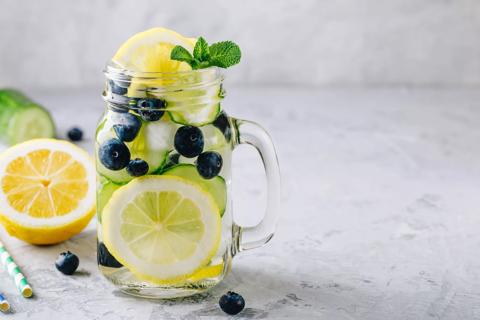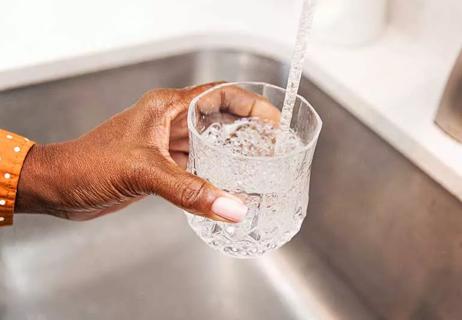Mold and bacteria in your reusable water bottle can cause health issues like infections, respiratory issues and allergic reactions

We all know the pros of using a reusable water bottle. It’s good for the environment, easy to carry and lets you drink enough water instead of refilling your glass. And while your water bottle can help you stay on top of your hydration, you should also stay on top of cleaning it.
Advertisement
Cleveland Clinic is a non-profit academic medical center. Advertising on our site helps support our mission. We do not endorse non-Cleveland Clinic products or services. Policy
You may assume that since you’re just using your water bottle for water, there’s no risk of contamination. What’s cleaner than H20, right? But mold and bacteria can sneak their way into your drinking water right under your nose.
Internal medicine physician Marianne Sumego, MD, explains how to prevent your water bottle from becoming a hub for mold and bacteria.
In short, absolutely. Your emotional support water bottle can quickly become a warm, cozy home for mold.
“Certain bacteria and molds depend on water,” explains Dr. Sumego. “Places like lakes or ponds become breeding grounds for bacteria to replicate. And in some cases, you end up with enough bacteria to get an infection if you drink the water.”
But mold and bacteria don’t just occur in nature — they can also creep up and take residence in many spots around your home. That’s why even your bathroom or shower can have mold problems.
Our water bottles are no exception. Think about it: When was the last time you emptied your water bottle? Most of us keep liquids in them all day, every day. Because of this, they rarely dry completely.
And without proper cleaning, your water bottle can become an ecosystem of mold and bacteria. This is thanks to its dark, moist and warm inside. It might start as tiny specks you can barely see. But if left unchecked, they can grow and contaminate the water you’re drinking.
Advertisement
Even though some foods, like cheese and mushrooms, are in the mold family, that doesn’t mean all mold is safe to consume. Ingesting mold can have certain health risks, especially if you consume it for long periods of time or are sensitive to it.
“When you find yourself with minor illnesses, such as nagging respiratory symptoms that aren’t improving, it may be tied to things you’re not cleaning,” Dr. Sumego says.
Health risks of consuming mold include:
“You might get a very mild case or something a bit more severe,” Dr. Sumego notes. “But if you’re at higher risk, repeated exposure to mold or bacteria can be more harmful and serious.”
Despite its reputation, mold may not always be obvious. As Dr. Sumego points out, the first signs of mold may be a more subtle, slimy texture.
“If you’ve ever let your bottle get to the point where there’s a thin film — it’s called biofilm — that’s a sign that bacteria and mold are building up,” she says.
The best way to figure out if your water bottle has mold is to follow your senses. Here are some things to look out for:
Advertisement
If you find mold in your water bottle, don’t panic. If you’ve only taken a few sips, you likely won’t experience any side effects. But everyone is different and could react to consuming mold differently, so pay close attention to how you’re feeling afterward.
First thing first: Stop drinking from the water bottle immediately. Then, it’s time to get cleaning!
You can start by disinfecting your water bottle with hot water and soap. A 2015 study also found that vinegar can help stop mold growth. To kill mold spores, you can use a vinegar solution (equal parts vinegar and water) in the water bottle to give it a deeper clean. Let the disinfectant sit in the bottle for a few minutes before rinsing it out thoroughly. (More on proper cleaning next.)
Finally, be sure to clean your water bottle so it dries completely. Remember, mold loves those damp environments.
Whether you’ve found mold or you want to prevent mold from forming in your water bottle, you’ll need to do more than just throw some water in and swish it around. “Once a week, you really want to run it through the dishwasher,” Dr. Sumego suggests. “That way, you get enough hot water in those nooks and crannies.”
If you can’t use a dishwasher, hand washing will do the trick, too. Here’s the best way to clean your water bottle to avoid mold growth:
Advertisement
Advertisement
So, how often should you be cleaning your water bottle to prevent mold growth? According to Dr. Sumego, you should give your water bottle a deep clean — breaking it down into parts like we mentioned — at least once a week.
On a daily basis, Dr. Sumego recommends at least rinsing out your bottle using warm water after every use. If you want to be extra safe, you can give it a quick wash with dish soap after every use as well (even if you don’t break it apart).
This will prevent your water bottle from growing mold and other types of bacteria from getting in your drinking water.
“People forget that we have bacteria in our mouths and hands,” Dr. Sumego states. “So, every time we touch and fill our bottles, set them down or take the caps off, we introduce bacteria.”
Learn more about our editorial process.
Advertisement

Consumption needs vary based on activity, weather, metabolism and other factors

A glass of lemon water in the morning can help with digestion and boost vitamin C levels, and may even help get you into a better routine

Sitting in the dry heat may help reduce stress, improve heart health and relieve pain

Adding salt to your water isn’t going to have measurable benefits — but there may be plenty of downsides

Drinking untreated water can have dangerous consequences, like bacterial infections

Although it adds to your hydration, this water may be pushing you over the limit of the daily recommended dosage of caffeine

If you’re trying to drink less soda or fewer sugary drinks, flavored water can be a delicious and healthy alternative

Your home’s tap water should be safe to drink, but you can install filters and run tests to be sure

Start having sex about 72 hours before ovulation, then at least every other day during your fertile window

Attachment theory suggests that your earliest relationships shape connections throughout your life

It isn’t a recognized mental health disorder, but research shows that problematic social media use can negatively affect your mental health, self-esteem and sleep